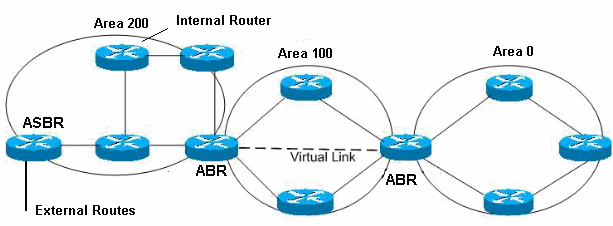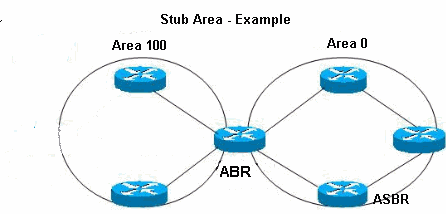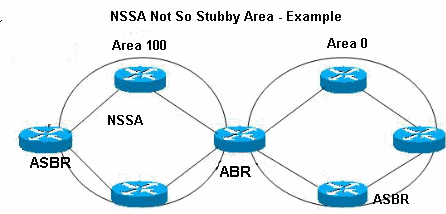Download practice tests: CCNA certification exams
OSPF stands for Open Shortest Path First.
Definition: OSPF is a routing protocol used to determine the best route for delivering the packets within an IP networks. It was published by the IETF to serve as an Interior Gateway Protocol replacing RIP. The OSPF specification is published as Request For Comments (RFC) 1247.
Note that OSPF is a link-state routing protocol, whereas RIP and IGRP are distance-vector routing protocols. Routers running the distance-vector algorithm send all or a portion of their routing tables in routing-update messages to their neighbors.
OSPF sends link-state advertisements (LSAs) to all other routers within the same area. Information on attached interfaces, metrics used, and other variables is included in OSPF LSAs. OSPF routers use the SPF (Shortest Path First) algorithm to calculate the shortest path to each node. SPF algorithm is also known as Dijkstra algorithm.
Advantages of OSPF
Disadvantages of OSPF:
OSPF Networking Hierarchy:
As mentioned earlier, OSPF is a hierarchical routing protocol. It enables better administration and smaller routing tables due to segmentation of entire network into smaller areas. OSPF consists of a backbone (Area 0) network that links all other smaller areas within the hierarchy. The following are the important components of an OSPF network:
Transit Areas

ABR: Area Border Router
ASBR: Autonomous System Boundary Router
Areas: An area consists of routers that have been administratively grouped together. Usually, an area as a collection of contiguous IP subnetted networks. Routers that are totally within an area are called internal routers. All interfaces on internal routers are directly connected to networks within the area.
Within an area, all routers have identical topological databases.
Area Border Routers: Routers that belong to more than one area are called area border routers (ABRs). ABRs maintain a separate topological database for each area to which they are connected.
Backbone Area: An OSPF backbone area consists of all routers in area 0, and all area border routers (ABRs). The backbone distributes routing information between different areas.
AS Boundary Routers (ASBRs): Routers that exchange routing information with routers in other Autonomous Systems are called ASBRs. They advertise externally learned routes throughout the AS.
Stub Areas: Stub areas are areas that do not propagate AS external advertisements. By not propagating AS external advertisements, the size of the topological databases is reduced on the internal routers of a stub area. This in turn reduces the processing power and the memory requirements of the internal routers.

Not-So-Stubby Areas (NSSA): An OSPF stub area has no external routes in it. A NSSA allows external routes to be flooded within the area. These routes are then leaked into other areas. This is useful when you have a non-OSPF router connected to an ASBR of a NSSA. The routes are imported, and flooded throughout the area. However, external routes from other areas still do not enter the NSSA.

Totally Stubby Area: Only default summary route is allowed in Totally Stubby Area.
Transit Areas: Transit areas are used to pass traffic from an adjacent area to the backbone. The traffic does not originate in, nor is it destined for, the transit area.
Link State Advertisements (LSAs):
It is important to know different Link State Advertisements (LSAs) offered by OSPF protocol.
Type 1: Router link advertisements generated by each router for each area it belongs to. Type 1 LSAs are flooded to a single area only.
Type 2: Network link advertisements generated by designated routers (DRs) giving the set of routers attached to a particular network. Type 2 LSAs are flooded to the area that contains the network.
Type 3/4: These are summary link advertisements generated by ABRs describing inter-area routes. Type 3 describes routes to networks and is used for summarization. Type 4 describes routes to the ASBR.
Type 5: Generated by the ASBR and provides links external to the Autonomous System (AS). Type 5 LSAs are flooded to all areas except stub areas and totally stubby areas.
Type 6: Group membership link entry generated by multicast OSPF routers.
Type 7: NSSA external routes generated by ASBR. Only flooded to the NSSA. The ABR converts LSA type 7 into LSA type 5 before flooding them into the backbone (area 0).
|
Area |
Restriction |
|
Normal |
None |
|
Stub |
Type 5 AS-external LSA NOT allowed |
|
NSSA |
Type 5 AS-external LSAs are NOT allowed, but Type 7 LSAs that convert to Type 5 at the NSSA ABR can traverse |
|
Totally Stubby |
Type 3, 4 or 5 LSAs are NOT allowed except the default summary route |
Disclaimer: Simulationexams.com is not affiliated with any certification vendor, and Sim-Ex™ Practice Exams are written independently by SimulationExams.com and not affiliated or authorized by respective certification providers. Sim-Ex™ is a trade mark of SimulationExams.com or entity representing Simulationexams.com.CCNA™ is a trademark of Cisco® systems